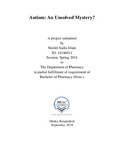| dc.contributor.advisor | Neelotpol, Sharmind | |
| dc.contributor.author | Islam, Sheikh Sadia | |
| dc.date.accessioned | 2018-11-28T05:47:07Z | |
| dc.date.available | 2018-11-28T05:47:07Z | |
| dc.date.copyright | 2018 | |
| dc.date.issued | 2018-09 | |
| dc.identifier.other | ID 14146011 | |
| dc.identifier.uri | http://hdl.handle.net/10361/10885 | |
| dc.description | This project report is submitted in partial fulfilment of the requirements for the degree of Bachelor of Pharmacy, 2018. | en_US |
| dc.description | Catalogued from PDF version of project report. | |
| dc.description | Includes bibliographical references (page 44-49). | |
| dc.description.abstract | Around the world, the rate of autism has consistently been rising. There are a few ecological factors working along with genetic susceptibilities that are contributing to this ascent. Being an undefined disease, autism shows some stereotype behaviors, for example: lining up toys, spinning objects, or opening and closing drawers or doors and no or less eye contact etc. that differs from person to person. The causes behind these stereotypical behaviors of autistic children are still an unsolved case to the researchers. Therefore, the aim of this study is to identify the probable etiologies of autism. By reviewing related articles, it have been found that some possible causes of autism are neurodevelopmental and environmental responsive genes for example NAGLU, FLAP, CHL1 etc. Some genetic syndrome like fragile X syndrome, tuberous sclerosis, rett syndrome etc. might also be the underlying causes of autism. Besides these causes, maternally derived autoantibodies, maternal infection, maternal antidepressant uses during pregnancy, maternal polycystic ovary syndrome, heavy metal and trace elements exposure, epigenetics etc. can also possibly cause autism. However, the researchers could confidently determine none of these causes to be responsible for autism and therefore the case has been unsolved so far. | en_US |
| dc.description.statementofresponsibility | Sheikh Sadia Islam | |
| dc.format.extent | 49 pages | |
| dc.language.iso | en | en_US |
| dc.publisher | BRAC University | en_US |
| dc.rights | BRAC University project reports are protected by copyright. They may be viewed from this source for any purpose, but reproduction or distribution in any format is prohibited without written permission. | |
| dc.subject | Autism | en_US |
| dc.subject | Autism Spectrum Disorders | en_US |
| dc.subject | Table Talk | en_US |
| dc.subject.lcsh | Autism. | |
| dc.title | Autism: an unsolved mystery? | en_US |
| dc.type | Project report | en_US |
| dc.contributor.department | Department of Pharmacy, BRAC University | |
| dc.description.degree | B. Pharmacy | |

